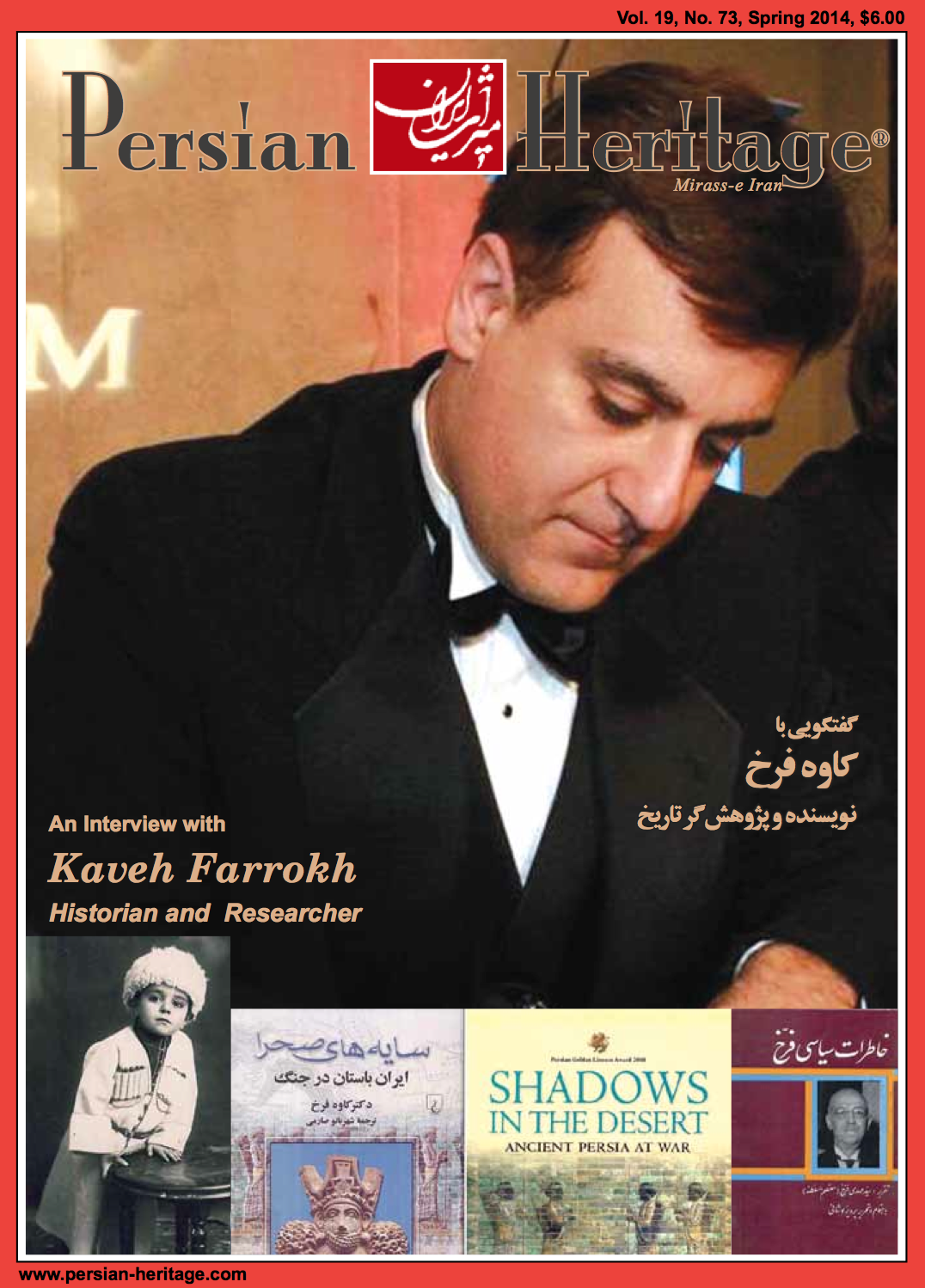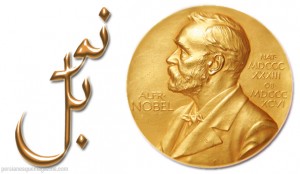Kaveh Farrokh has been interviewed by the Persian Heritage Magazine (published March 31, 2014) and Voice of America (published April 1, 2014) regarding the 300 sequel and Noah (starring Russell Crowe).
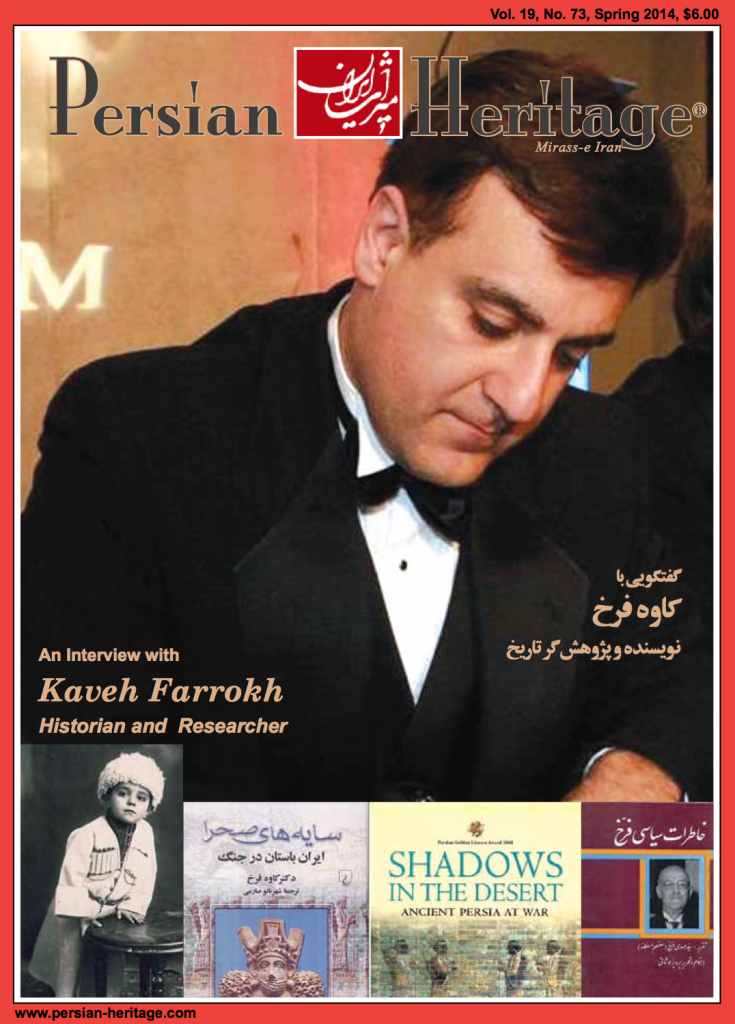 Persian Heritage Magazine (Volume 19, Number 73, Spring 2014, pp.32-34) – download edition in pdf. Note that the text/interview is in Persian. The above picture of Farrokh is from the WAALM event in London where he received the “Best History Book of 2008″ award for “Shadows in the Desert: Ancient Persia at War (see also BBC-Persian report). The book has been translated into Persian by two separate publishing houses in Iran (Qoqonoos publishing-see Mehr News & Press TV report and Taghe Bostan Publishers of Kermanshah Azad University) and Russian (consult Russian EXMO Publishers website). Farrokh’s book was also nominated as one of three finalists for the Benjamin Franklin Award in 2008. The book has also been reviewed in peer-reviewed academic journals such as the Iranshenasi Journal (2010) and the Quarderni Asiatici Journal of Italy (2011). In addition to teaching history at the University of British Columbia, Farrokh also serves as استاد سنتها و تاریخ فرهنگی ازدانشکده دیپلماسی فرهنگی وآلم ـ انگلستان-Chair of the Cultural Diplomacy’s Department of Traditions & Cultural History of the WAALM Academy in London, England (see also Academia.edu).
Persian Heritage Magazine (Volume 19, Number 73, Spring 2014, pp.32-34) – download edition in pdf. Note that the text/interview is in Persian. The above picture of Farrokh is from the WAALM event in London where he received the “Best History Book of 2008″ award for “Shadows in the Desert: Ancient Persia at War (see also BBC-Persian report). The book has been translated into Persian by two separate publishing houses in Iran (Qoqonoos publishing-see Mehr News & Press TV report and Taghe Bostan Publishers of Kermanshah Azad University) and Russian (consult Russian EXMO Publishers website). Farrokh’s book was also nominated as one of three finalists for the Benjamin Franklin Award in 2008. The book has also been reviewed in peer-reviewed academic journals such as the Iranshenasi Journal (2010) and the Quarderni Asiatici Journal of Italy (2011). In addition to teaching history at the University of British Columbia, Farrokh also serves as استاد سنتها و تاریخ فرهنگی ازدانشکده دیپلماسی فرهنگی وآلم ـ انگلستان-Chair of the Cultural Diplomacy’s Department of Traditions & Cultural History of the WAALM Academy in London, England (see also Academia.edu).
Kaveh Farrokh was also interviewed with other participants in the Voice of American Persian program entitled
صدای امریکا -برنامه افق-با میزبانی سیامک دهقانپور-تاریخ و سینما: از ۳۰۰ تا نوح-Voice of America – The Horizon – Hosted by Siamak Dehghanpur – Date Cinema: From 300 to Noah. Note that Farrokh had already published an extensive retort against the first “300” movie (2007) entitled: The 300 Movie: separating fact from Fiction.
The program produced a lively discussion, but unfortunately the shortage of time prevented the full exploration of a number of points, namely whether (1) the movie is political in nature and (2) Zoroastrianism and the Achaemenids. Five more topics also need to be discussed in two more follow-up postings, but for now, topics (1) and (2) are discussed below:
(1) The proposal that the new “300” movie does not serve any particular political and especially anti-Iranian agenda
It was suggested (not by Kaveh Farrokh) that the movie is entertainment cinematography and not intended to be an anti-Iranian picture. This notion is challenged by a number of prominent Western professors and journalists. Professor John Trikeriotis (himself of Greek ancestry) has begun a petition entitled: Adding a disclaimer or explanatory message to “300: Rise of an Empire”. Readers are strongly encouraged to sign the petition and support Professor Trikeriortis’ initiative.
 Professor John Trikeriotis strongly opposes the false historical messages in the movie “300 Rise of an Empire”. He has initiated a petition against the movie (click here…)
Professor John Trikeriotis strongly opposes the false historical messages in the movie “300 Rise of an Empire”. He has initiated a petition against the movie (click here…)
Akbar Montaser, one of the regular readers of Kavehfarrokh.com noted the following on April 7, 2013: “I still believe there is a tendency to demean Iran. This is done “cleverly”, not intelligently. If one does not see the Truth, the same disasters will be repeated based on history“. It is in this light that readers are introduced to the excellent article by Jehanzeb Dar in Racialicious: intersection of racism and Pop Culture:”Frank Miller’s “300′′ and the persistence of accepted Racism“. Below are some quotes from Jehanzeb Dar’s article:
“I was absolutely outraged by the racist content of the film and more so at the insensitivity of movie-goers who simply argued “it’s just a movie.” Later on, I would hear these same individuals say, “The movie makes you want to slice up some Persians”…“300”…represents the ever-growing trend of accepted racism towards Middle-Easterners in mainstream media and society, but also the reinforcement of Samuel P. Huntington’s overly clichéd, yet persisting, theory of “The Clash of Civilizations” which proposes that cultural and religious differences are the primary sources for war and conflict rather than political, ideological, and/or economic differences. …“300” grossed nearly $500 million worldwide in the box office…suggest that movie-goers share the film’s racist and jingoistic views…”
The late Samuel Huntington’s Eurocentric (if not racist) formula is unhelpful as it diverts the discussion away from the real causes of contemporary military conflicts, which are for the main part based on economics and geopolitical factors.
 The late Professor Samuel Huntington (1927-2008) who proposed the idea that wars are the result of the “Clash of Civilizations”. Huntington’s thesis has helped re-invigorate Eurocentric views of “race” and how these “explain” the so-called “East vs. West” paradigm. The “300” movies represent the revival of Eurocentricism in entertainment, the media in general and increasingly in academia, even within Iranian Studies: see for example a conference in Washington DC (March 9, 2013) and the petition of Professor Yarshater against the appointment of unqualified persons in Iranian Studies programs (December, 3, 2013).
The late Professor Samuel Huntington (1927-2008) who proposed the idea that wars are the result of the “Clash of Civilizations”. Huntington’s thesis has helped re-invigorate Eurocentric views of “race” and how these “explain” the so-called “East vs. West” paradigm. The “300” movies represent the revival of Eurocentricism in entertainment, the media in general and increasingly in academia, even within Iranian Studies: see for example a conference in Washington DC (March 9, 2013) and the petition of Professor Yarshater against the appointment of unqualified persons in Iranian Studies programs (December, 3, 2013).
Revisiting the notion of “300” being “harmless entertainment”, let us return to Jehanzeb Dar’s article cited earlier. The movie clearly attempts a Eurocentric-style “East = backwardness and oppression” versus “West=Freedom and Democracy“. This is again overly simplistic, as Demos (People) Kratus (rule) or Democracy in Athens did not apply to the entirety of society, especially to women. This is exemplified by Greek philosophers such as Socrates (d. 399 BCE) who stated in his Book 8 that “…one sign of democracy’s moral failure is the sexual equality it promotes” (563b; consult Nickolas Pappas, 2003, Routledge Philosophy Guidebook to Plato and the Republic, New York: Routledge). The topic of women’s rights in ancient Achaemenid Persia, and the views of women by contemporary Greek philosophers shall be addressed in ensuing postings.
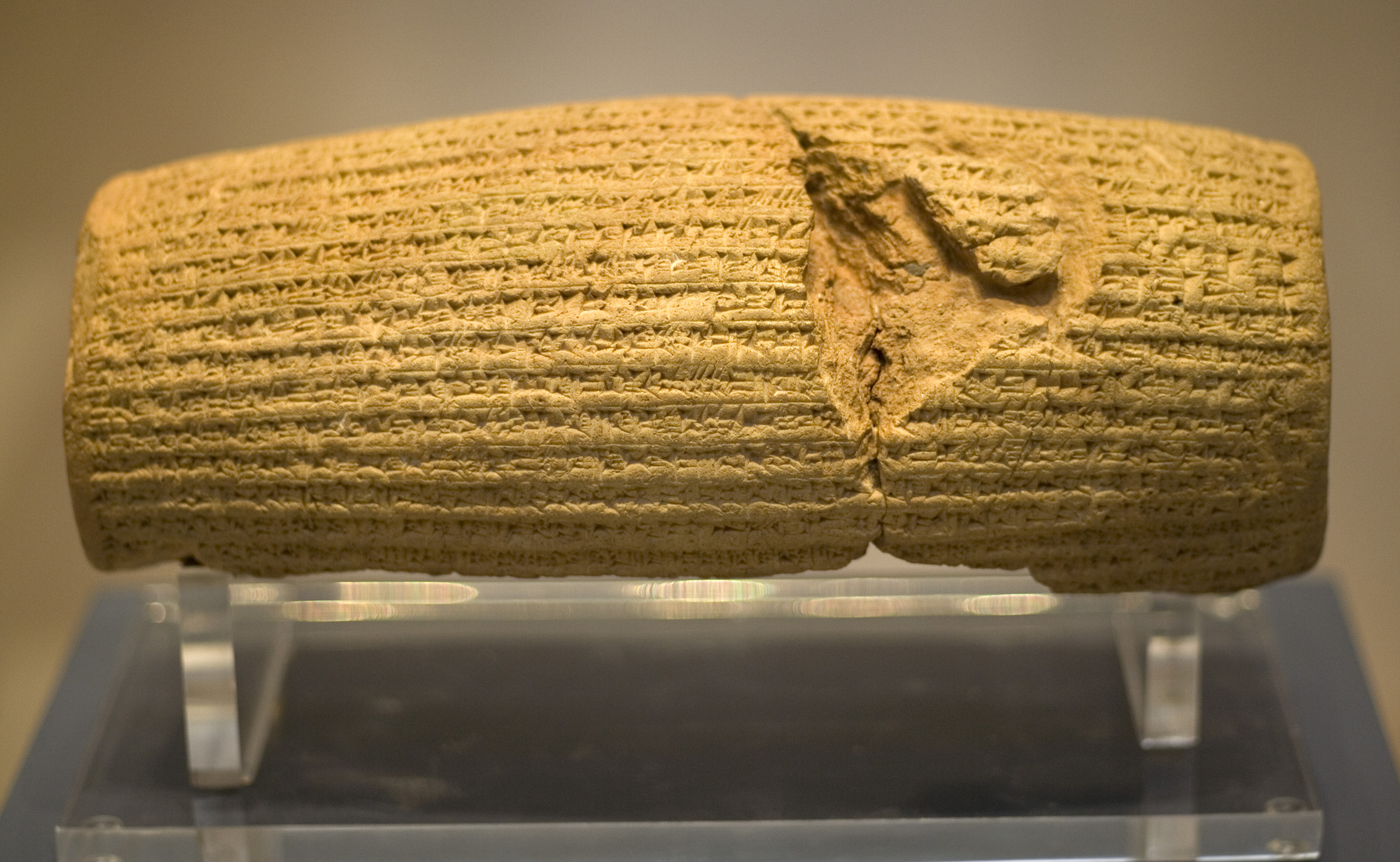 The Cyrus Cylinder (Picture Source: Angelina Perri Birney – see her article here…). Just as Greece was evolving with the concept of Democracy, so too had the Achaemenids proclaimed the freedom of peoples to practice their cultures and religions, as exemplified by the cylinder proclamation of Cyrus the Great (559-530 BCE). The history of Cyrus’ proclamation has been challenged by what some would regard as Eurocentric views (see Human Rights Petition…)
The Cyrus Cylinder (Picture Source: Angelina Perri Birney – see her article here…). Just as Greece was evolving with the concept of Democracy, so too had the Achaemenids proclaimed the freedom of peoples to practice their cultures and religions, as exemplified by the cylinder proclamation of Cyrus the Great (559-530 BCE). The history of Cyrus’ proclamation has been challenged by what some would regard as Eurocentric views (see Human Rights Petition…)
There is in fact strong coordination between Hollywood Heads and Studios and US foreign affairs departments. Consult reports below by highly reputable media outlets:
- New York Times: Walking with Presidents and Hollywood Kings
- New York Times: Head of Hollywood, Jack Valenti – Adviser to the US President
- Hollywood Reporter: Studio Heads Describe Private Meeting with Obama as ‘Love Fest’
- Hollywood Reporter: President Obama Holds Secret Meet-and-Greet With Hollywood Execs and Influencers (Exclusive)
- Daily Mail: US President Visits Hollywood
The Office of the Coordinator of Inter-American Affairs (established in the 1940s) was tasked to promote inter-American cooperation during the 1940s in the distribution of news, films and advertising, to counter the propaganda of World War Two fascist Italy and Nazi Germany.
The Office of the Coordinator of Inter-American Affairs was later renamed as the Office of Inter-American Affairs (OIAA) with slightly changed powers as per Executive order 9532 on March 23, 1945.
Readers are also invited to consult the article “Re-Birth of a Nation“, penned by Osagie K. Obasogie and posted in Genetics and Society on September 19th, 2007 with respect to the first 300 movie. Below are some excerpts of the Obasogie article:
“…300 is arguably the most racially charged movie since D.W. Griffith’s The Birth of a Nation. In true post-9/11 form, Zack Snyder’s film turns Brown into the new Black; Persians are depicted as bloodthirsty savages thwarted … by a small contingent of freedom fighters – with noticeably paler skin – looking to preserve democracy at all costs. This eerily resembles Birth of a Nation, the 1915 epic celebrating the Ku Klux Klan’s rise … to defend Southern whites’ dignity and honor against what were then seen as recently liberated Black insurgents. Like Griffith’s film, this mixture of race, racism, sex… racialized depiction of freedom, nation, and democracy becomes central to 300’s … message. But closer inspection reveals a subtler, yet similarly troubling idea that has gone largely unnoticed: 300’s unapologetic glorification of eugenics.”
Whether one chooses to agree or not with Osagie K. Obasogie or Jehanzeb Dar, serious questions may be raised as to the picture’s true intentions. By the same token, profound political and ideological divisiveness has prevented the Iranian community (diaspora and inside Iran) from coalescing towards a concerted approach. There is for example no real “Iranian anti-defamation League” to protest against Hollywood producers and international cultural venues in general for presenting Iranians as propaganda targets.
The WAALM School of Cultural Diplomacy however, has worked towards the establishment of cultural dialogue at the international level with success, and has in fact been nominated for the Nobel Peace Prize in 2011 (see also original report: Nobel Peace Prize 2011: World Academy of Arts, Literature and Media (WAALM) Nominated | Persianesque: Iranian Magazine). For more on WAALM’s initiative in international diplomacy click on the image below:
(2) The Achaemenids and Zoroastrianism
Towards the end of the program one of the participants asserted that there is “no absolute proof that Achaemenids were Zoroastrian“. Farrokh only had a few minutes to respond adequacy and in full, which is why this complex topic, which is why it needs to be re-addressed. In principle, yes, the Achaemenids were not Zoroastrian in the sense of an institutionalized religious system during the Sassanian era (like Papacy of Rome), however the notion that they (Achaemenids) were “not Zoroastrian” is highly misleading.
First, the doctrine of Zoroastrianism versus the religious institution of Zoroastrianism cannot be so simplistically equated. The Achaemenids did know of Zoroaster’s teachings, however these were yet be institutionalized into a complex state religious system, as occurred (in its finalized form) during the Sassanian era (224-651 CE).
There is clear proof that Zoroaster and his teachings were known in the ancient world. Xanthus of Lydia for example, who was a contemporary of Herodotus (5th century BCE), is the first westerner to mention Zoroaster by name (Yamauchi, 1990, p.400). Herodotus (like Plutarch later in the 2nd century CE) does not mention Zoroaster by name, but his descriptions of the tribe of the Magi priesthood and Persian customs clearly point to Zoroastrian beliefs (in Chapter XIII of Herodotus’ The Histories, Penguin Classics, London: England, 1972). Similar classical descriptions are found in Strabo (63 BCE-19 CE) where references are made to the Magus, worship practices and the god Mithras (passage 15.3.13-14 of Strabo, Geography, translated by H. L. Jones (ed.), Perseus project, Tufts University, 2000). For more on this subject, a list of readings are provided at the conclusion of this section.
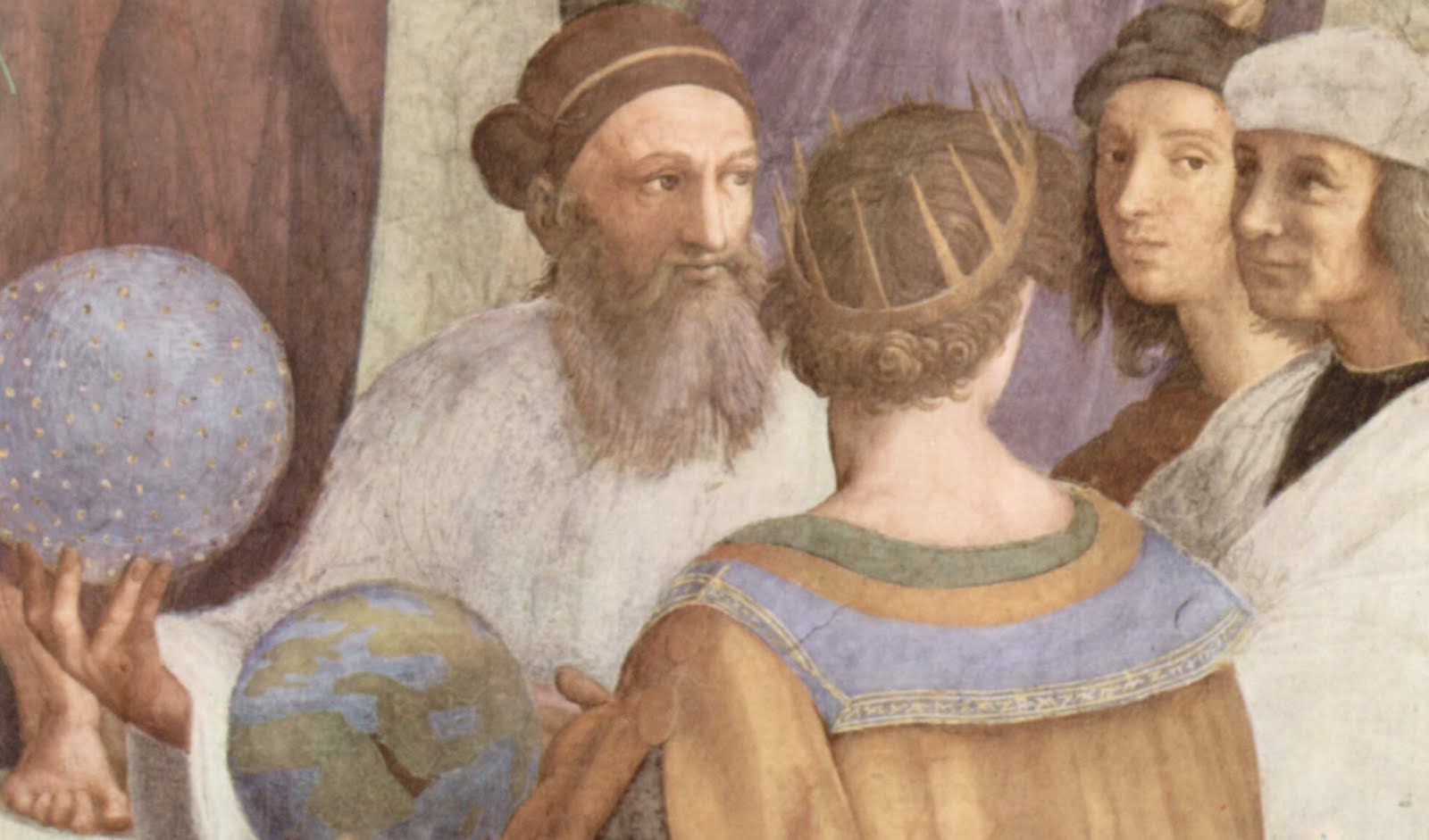 A detail of the painting “School of Athens” by Raphael 1509 CE (Source: Zoroastrian Astrology Blogspot). Raphael has provided his artistic impression of Zoroaster (with beard-holding a celestial sphere) conversing with Ptolemy (c. 90-168 CE) (with his back to viewer) and holding a sphere of the earth. Note that contrary to Samuel Huntington’s “Clash of Civilizations” paradigm, the “East” represented by Zoroaster, is in dialogue with the “West”, represented by Ptolemy. Prior to the rise of Eurocentricism in the 19th century (especially after the 1850s), ancient Persia was viewed positively by the Europeans.
A detail of the painting “School of Athens” by Raphael 1509 CE (Source: Zoroastrian Astrology Blogspot). Raphael has provided his artistic impression of Zoroaster (with beard-holding a celestial sphere) conversing with Ptolemy (c. 90-168 CE) (with his back to viewer) and holding a sphere of the earth. Note that contrary to Samuel Huntington’s “Clash of Civilizations” paradigm, the “East” represented by Zoroaster, is in dialogue with the “West”, represented by Ptolemy. Prior to the rise of Eurocentricism in the 19th century (especially after the 1850s), ancient Persia was viewed positively by the Europeans.
If Greco-Roman sources are so clear about Zoroaster’s doctrines, then how can the Achaemenids not have known of Zoroaster, or respected his teachings?
Much like later Christianity, when the early doctrines of Christ predated the religious institution of Christinaity, so too did the doctrines of Zoroaster precede the religious institution of Sassanian Zoroastrianism. A (broadly-speaking) similar process occurred with respect to Christ’s early teachings when Emperor Constantine the Great (r. 306-337 CE) declared Christianity as the official religion of the Roman Empire.
The question is how were Zoroastrian doctrines practiced during the Achaemenid era as ancient Iranian theology was invariably complex (as attested to in Zoroastrian documents). Zoroaster was, in a sense, a reformer of the more ancient Iranian cults, perhaps he was at first one of the followers of the cult of Mithras, but direct evidence is certainly lacking for this suggestion. What is clear is that there is solid proof of Achaemenid respect for Zoroaster’s teachings, as seen with the Zoroastrian Fravahar symbol depicted at Persepolis:
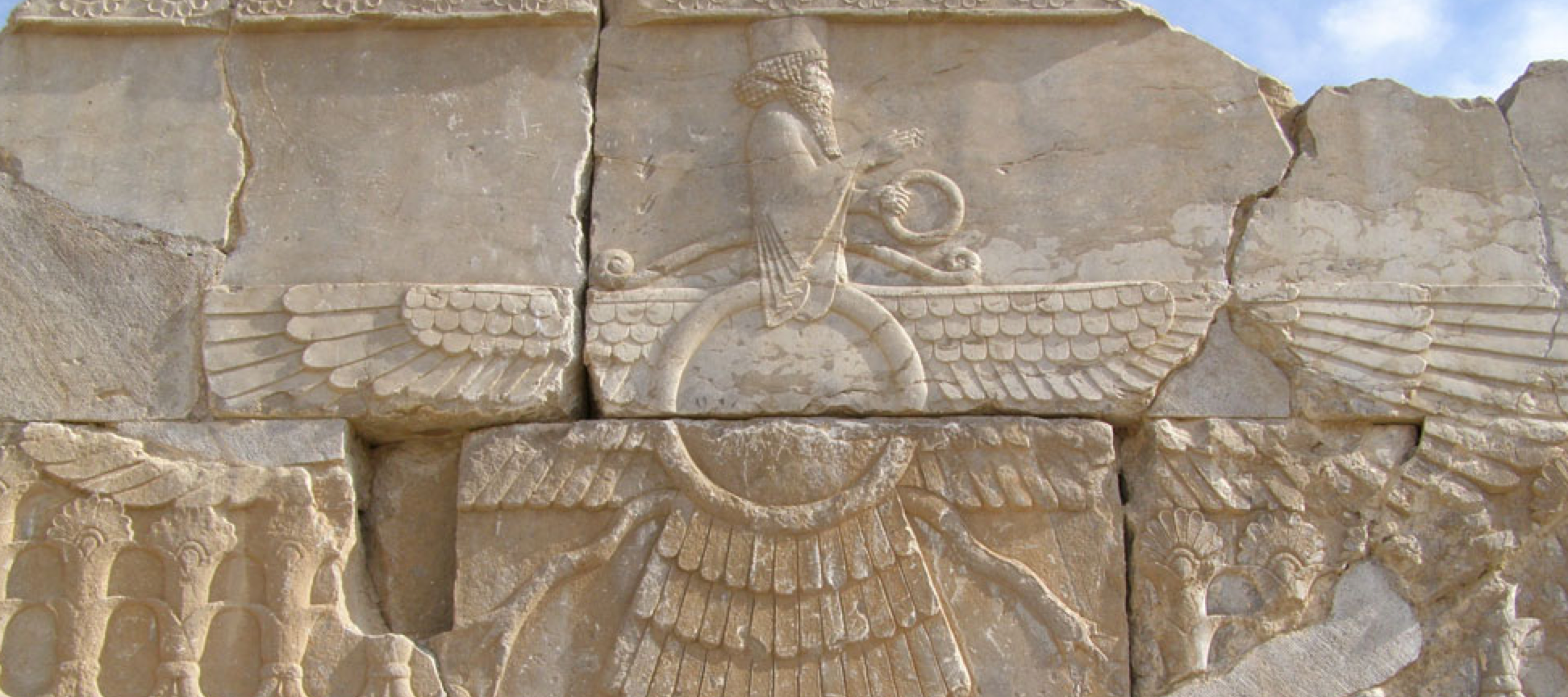 Depiction of the Zoroastrian Fravahar at Persepolis (Photo source: Mani Moradi, 2012). This indicates that the doctrines of Zoroaster were known by the Achaemenids, and they clearly respected these, as indicated by the depiction of this symbol at their regal locale of imperial power.
Depiction of the Zoroastrian Fravahar at Persepolis (Photo source: Mani Moradi, 2012). This indicates that the doctrines of Zoroaster were known by the Achaemenids, and they clearly respected these, as indicated by the depiction of this symbol at their regal locale of imperial power.
To further consult this topic, readers are referred to:
- Nigosian, S.A. (1993). The Zoroastrian Faith: Tradition and Modern Research. Montreal & Kingston: Mcgill-Queen’s University Press.
- Yamauchi, E.M. (1990). Persia and the Bible. Grand Rapids, Michigan: Baker Book House; see especially chapters 12 (Zoroastrianism), 13 (The Magi) and 14 (Mithraism).
- Boyce, M. (2001; first published in 1979). Zoroastrians: Their Religious beliefs and Practices. London: Routledge Taylor & Frances Group.
- Kriwaczek, P. (2003). In Search of Zarathustra: The First prophet and the Ideas that Changed the World. Weidenfeld & Nicolson.
Future postings will further discuss topics related to the “300” sequel movie discussed in the Voice of America interview:
- The real reason for war: commerce and economics
- Military falsifications of the 300 movie
- The historical Themistocles
- Women of ancient Iran
- “Nordification” of ancient Greeks

